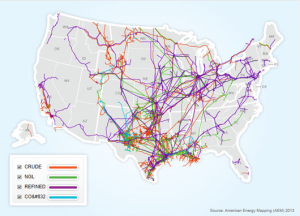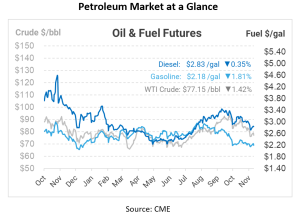
What is it – Pipeline
North America is home to an extensive network on both interstate and intrastate pipelines that serve in the transportation of petroleum products across the continent. Pipelines are instrumental in powering our nation’s daily operations and sustaining our livelihoods by delivering the needed energy resources. In this edition of What Is It Wednesday, we will be exploring what oil and gas pipelines are, how fuel gets from point A to point B on the pipeline, and highlight some proposed projects and regulations.
What is a pipeline?
At its most basic level, a pipeline is a system of connected tubes or pipes that transport liquids or gases from one location to another, operating on a continual 24/7 timetable. When it comes to petroleum products, pipelines are the most efficient, cost-effective, and environmentally friendly means of transporting fuel over long distances.
Pipelines can range in size from a few inches in diameter to over four feet, and they can stretch for thousands of miles, traversing various terrains and even running underwater. Due to the fact that oil and gas pipelines are often hidden from public view, many people are oblivious to the extensive network of pipelines that exist. The U.S. alone boasts an extensive network of approximately 2.6 million miles of pipelines, transporting everything from crude oil and refined petroleum products to natural gas and biofuels.
How Do Pipelines Work?
Pipelines utilize pumps and compressors to keep the product moving at a steady pace. The fuel is typically separated into batches based on its type (e.g., gasoline, diesel, jet fuel) and is pushed through the pipeline by the pressure created by the pumps and compressors. In addition to fuel, pipelines often carry other essential additives that help to improve the flow and safety of product in the pipe.
Where Does the Product Come From?
The journey of your fuel product begins at the extraction site, where crude oil is pulled from underground reservoirs. The crude oil is then transported to refineries via pipelines, where it is processed into various fuel products such as gasoline, diesel, and jet fuel.
The U.S. is a major producer of crude oil, with significant extraction operations in states such as Texas, North Dakota, and Alaska. In addition to domestic production, the U.S. also imports crude oil from countries such as Canada, Mexico, and Saudi Arabia. Once at the refinery, the crude oil is heated and separated into different components based on their boiling points, producing the various fuel products that we use in our everyday lives.
Where Does the Fuel Go After the Pipeline?
Once the fuel products have been processed and refined, they are once again transported via pipeline to storage facilities and distribution centers across the country. From there, the fuel is loaded onto trucks or trains and delivered to local gas stations, airports, or other fuel distributors, where it is ultimately sold to end consumers like you.
Is the U.S. Equipped with Adequate Pipeline Infrastructure?
Boasting the world’s most extensive crude oil pipeline network, coupled with its position as the world’s leading oil producer, the U.S. is well-furnished with pipelines. Yet, an interesting fact is that approximately half of the oil pipeline capacity remains unused. Pre-pandemic, these pipelines were running at between 60% to 70% of their capacity, with numerous additional lines under construction to accommodate the booming oil production.
Rising gas prices and geopolitical tensions have resulted in a shift in demand towards domestic gas companies, and the U.S. is currently witnessing a transformation in its energy landscape. The Biden administration’s focus on environmental policies adds another layer of complexity to the pipeline construction process.
Securing permits for new pipeline construction has become increasingly challenging, and adhering to stringent environmental regulations adds to the expense of the construction process. In 2022, oil pipeline construction decreased by 13.4%. The economic viability of oil pipeline construction in 2023 is significantly less compared to previous years.
As the energy landscape continues to evolve, new pipelines can become necessary to address production from new areas or an increased flow of product between different regions. For instance, more pipelines continue being built to bring oil from West Texas over to the Gulf Coast.
However, the existing pipelines require continuous maintenance and refurbishment. Many important pipelines are 50 years old – or even older – creating supply risk in some areas. Future developments may necessitate more extensive pipeline infrastructure to meet the demands of a changing energy landscape.

What are the major US pipelines, and what happens if one shuts down?
Some of the major pipelines in the U.S. include the Keystone Pipeline, Dakota Access Pipeline, Colonial Pipeline, Trans-Alaska Pipeline System, and the Enbridge Pipeline System. The Colonial pipeline holds the title as the world’s longest, with 51% of the total length located in the region. This pipeline is a joint venture owned by several major corporations and stretches from Texas all the way to New York. The process of transporting a batch of fuel from Texas to New York Harbor is a considerable undertaking, taking approximately 18.5 days to complete the journey.

When a major pipeline shuts down, the effects can be wide-ranging. Supply shortages are a primary concern, as pipelines are the principal means of transporting oil and gas. A lack of supply can then lead to price increases, affecting the cost of gasoline, heating oil, and other products derived from crude oil. This, in turn, can have significant economic impacts, including job losses and reduced profits for companies in the energy sector.
Pipeline shutdowns can also have environmental implications. Without pipelines, companies may have to rely more on trucks and trains to transport oil and gas, which can result in greater greenhouse gas emissions and other environmental harms. Pipelines are often shut down as a precautionary measure in response to security threats or natural disasters to prevent potential accidents or attacks that could have catastrophic consequences. An example of this was the ransomware attack on the Colonial Pipeline in May 2021, which led to gasoline shortages and price increases along the East Coast of the U.S.

This article is part of Daily Market News & Insights
Tagged: pipelines
MARKET CONDITION REPORT - DISCLAIMER
The information contained herein is derived from sources believed to be reliable; however, this information is not guaranteed as to its accuracy or completeness. Furthermore, no responsibility is assumed for use of this material and no express or implied warranties or guarantees are made. This material and any view or comment expressed herein are provided for informational purposes only and should not be construed in any way as an inducement or recommendation to buy or sell products, commodity futures or options contracts.





